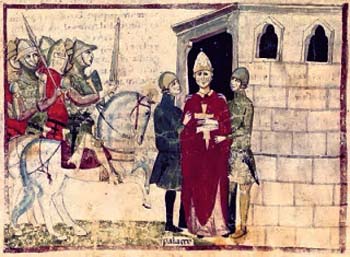Theology of History
 |
 |
 |
 |
 |
 |
 |
Beware of the Breeze of Butterfly Wings
In his scholarly work Revolution and Counter-Revolution, Dr. Plinio Corrêa de Oliveira describes the three stages of human activity that result in crimes against God and man. For instance, before the French Revolution became a fact, it existed in the mind of man, in his ideas; and, previous to that it was latent but real in his tendencies. One can say that in its tendencies the French Revolution was already contained in Protestantism. As he puts it:
“Like cataclysms, the evil passions have an immense power, but that power is to destroy. In the first instant of its great explosions, this force already has the potential for all the virulence it will manifest later in its worst excesses.
“In the first denials of Protestantism, for example, the anarchical yearnings of Communism were already implicit. From the point of view of his explicit formulations, one can say that Luther was no more than Luther. Nevertheless, all the tendencies, all the states of soul, and all the imponderables of the Lutheran explosion already bore within them, in an authentic and full but implicit way, the spirit of Voltaire and Robespierre, of Marx and Lenin.” (1)
 We can visualize this latent but real tendency via a striking analogy. In the 1960s, Edward Lorenz, an MIT meteorologist popularized the notion of the butterfly effect. He wrote that “an infinitesimal shift in the weather – say, the turbulence caused by a butterfly flapping its wings – can set in motion atmospheric events that climax in a hurricane. Such events are for all practical purposes unpredictable.” (2)
We can visualize this latent but real tendency via a striking analogy. In the 1960s, Edward Lorenz, an MIT meteorologist popularized the notion of the butterfly effect. He wrote that “an infinitesimal shift in the weather – say, the turbulence caused by a butterfly flapping its wings – can set in motion atmospheric events that climax in a hurricane. Such events are for all practical purposes unpredictable.” (2)
Lorenz was attempting to predict gigantic failures of today’s mega-systems, power networks, communications, transportation, and so on through his “chaos theory.” Physicist Ben Carreras of Oak Ridge National Laboratory in Tennessee comments on such potential super-power failures, “The whole grid is very strongly coupled, and when you do something in one point, it can affect the system very far away.” (3)
Some examples. In the spring of 1918 a flu virus known later as ‘the great influenza' broke out in two army training camps in Kansas. Soldiers carried the virus overseas during World War I, and in two years it killed about 100 million people globally,' including Jacinta and Francisco. (4) A virus, dubbed “the invisible enemy” is, therefore, a good example of the ‘butterfly wings,’ impalpably imperceptible.
Regardless of the truth of Lorenz’ chaos theory, the butterfly wings allegory raises an interesting point: how latent and often barely perceptible errors can result in astounding victories for the Revolution.
Moving to the spiritual terrain, we see how Satan uses the same tactics to wage his war against the designs of God. It was so from the beginning. Mary of Agreda describes how Satan’s revolt was not a momentary decision, but was formed gradually from a single bad disposition. He did not accept freely and with love the Incarnation of Our Lord Jesus Christ, as the good angels did. Then, “following this bad inclination that at times filled Lucifer, he fell into a most disorderly self-love.”(5) This cause found its effect in hatred of God and his final revolt.
Butterfly wings & the Revolution
To understand how the Revolution brought us to the point we are today, it is useful to understand just how the Middle Ages ended. With its demise came the dimming of its love of God, true devotion to the Cross, love of sacrifice, aspiration to sanctity and eternal life.
 What destroyed that glorious era began in the tendencies of man, the flapping of butterfly wings in the souls of men who eschewed what God demands. The two tools employed by Satan – always the same – were pride and sensuality.
What destroyed that glorious era began in the tendencies of man, the flapping of butterfly wings in the souls of men who eschewed what God demands. The two tools employed by Satan – always the same – were pride and sensuality.
An event marks the beginning of the end of the Middle Ages. Prof. Plinio signals this moment as the Slap of Anagni in September 1303, when Sciarra Colonna slapped Pope Boniface VIII in the face. (6)
The 14th century began with optimism. Pope Boniface VIII (1294-1303) proclaimed a Jubilee to celebrate the new centenary of Christ’s birth. Throngs estimated at two million came to Rome. Boniface had before him the example of Innocent III, a Pope so skilled at asserting his supremacy over Emperors and Kings that he had humbled five of them by excommunications or interdicts.
Yet Boniface, who sought to continue the glory of the Middle Ages, failed, and was profoundly humbled in his strife with Philip the Fair, King of France (1285-1314), who asserted his power was greater than the Pope’s. Boniface VIII responded with the Bull Unam Sanctam, which affirmed that Kings must always obey the Popes.
Philip dispatched one of his chief advisors, William of Nogaret and Italian papal enemy Sciarra Colonna, accompanied by a band of hired ruffians, to deal personally with Boniface, who was at the Castle of his family in Anagni. They not only insulted him, but Colonna struck him with his iron glove. A few weeks later on October 11, 1303, the Pope died as a consequence of the violence to which he had been subjected.
 The lesson here is this: The slap of the Pope was an action fed by revolutionary ideas, that had been nourished by humanist and absolutist tendencies, which had taken root in the 13th century. The result was that symbolic act, which effectively marked the end of the Middle Ages, since in the next two centuries Humanism and the Renaissance would replace that magnificent era of History turned toward serving God.
The lesson here is this: The slap of the Pope was an action fed by revolutionary ideas, that had been nourished by humanist and absolutist tendencies, which had taken root in the 13th century. The result was that symbolic act, which effectively marked the end of the Middle Ages, since in the next two centuries Humanism and the Renaissance would replace that magnificent era of History turned toward serving God.
We live in times much worse: Progressivism in the Church is the worst heresy that has beset her throughout her History. Under Francis, it is roaring ahead full steam.
The resistance we are called upon by Our Lady to practice requires fierce heroism and balance, and the determination to extirpate the very roots of Revolution in the Church. The protocol for our resistance has been set down with clarity and acumen in the book We Resist You to the Face, (7) which I strongly encourage my readers to carefully peruse.
May Our Lady of Fatima protect us and help us to always conduct our fight according to the guidance of Her Immaculate Heart.

Posted September 2, 2013
“Like cataclysms, the evil passions have an immense power, but that power is to destroy. In the first instant of its great explosions, this force already has the potential for all the virulence it will manifest later in its worst excesses.
“In the first denials of Protestantism, for example, the anarchical yearnings of Communism were already implicit. From the point of view of his explicit formulations, one can say that Luther was no more than Luther. Nevertheless, all the tendencies, all the states of soul, and all the imponderables of the Lutheran explosion already bore within them, in an authentic and full but implicit way, the spirit of Voltaire and Robespierre, of Marx and Lenin.” (1)

According to Lorenz, the flutter of a butterfly' wings across the ocean could cause a tornado in the U.S.
Lorenz was attempting to predict gigantic failures of today’s mega-systems, power networks, communications, transportation, and so on through his “chaos theory.” Physicist Ben Carreras of Oak Ridge National Laboratory in Tennessee comments on such potential super-power failures, “The whole grid is very strongly coupled, and when you do something in one point, it can affect the system very far away.” (3)
Some examples. In the spring of 1918 a flu virus known later as ‘the great influenza' broke out in two army training camps in Kansas. Soldiers carried the virus overseas during World War I, and in two years it killed about 100 million people globally,' including Jacinta and Francisco. (4) A virus, dubbed “the invisible enemy” is, therefore, a good example of the ‘butterfly wings,’ impalpably imperceptible.
Regardless of the truth of Lorenz’ chaos theory, the butterfly wings allegory raises an interesting point: how latent and often barely perceptible errors can result in astounding victories for the Revolution.
Moving to the spiritual terrain, we see how Satan uses the same tactics to wage his war against the designs of God. It was so from the beginning. Mary of Agreda describes how Satan’s revolt was not a momentary decision, but was formed gradually from a single bad disposition. He did not accept freely and with love the Incarnation of Our Lord Jesus Christ, as the good angels did. Then, “following this bad inclination that at times filled Lucifer, he fell into a most disorderly self-love.”(5) This cause found its effect in hatred of God and his final revolt.
Butterfly wings & the Revolution
To understand how the Revolution brought us to the point we are today, it is useful to understand just how the Middle Ages ended. With its demise came the dimming of its love of God, true devotion to the Cross, love of sacrifice, aspiration to sanctity and eternal life.

Philip the Fair sent two agents - Nogaret & Colonna - to accost Pope Boniface VIII
An event marks the beginning of the end of the Middle Ages. Prof. Plinio signals this moment as the Slap of Anagni in September 1303, when Sciarra Colonna slapped Pope Boniface VIII in the face. (6)
The 14th century began with optimism. Pope Boniface VIII (1294-1303) proclaimed a Jubilee to celebrate the new centenary of Christ’s birth. Throngs estimated at two million came to Rome. Boniface had before him the example of Innocent III, a Pope so skilled at asserting his supremacy over Emperors and Kings that he had humbled five of them by excommunications or interdicts.
Yet Boniface, who sought to continue the glory of the Middle Ages, failed, and was profoundly humbled in his strife with Philip the Fair, King of France (1285-1314), who asserted his power was greater than the Pope’s. Boniface VIII responded with the Bull Unam Sanctam, which affirmed that Kings must always obey the Popes.
Philip dispatched one of his chief advisors, William of Nogaret and Italian papal enemy Sciarra Colonna, accompanied by a band of hired ruffians, to deal personally with Boniface, who was at the Castle of his family in Anagni. They not only insulted him, but Colonna struck him with his iron glove. A few weeks later on October 11, 1303, the Pope died as a consequence of the violence to which he had been subjected.

Francis speeds up the revolution to destroy the papal dignity. Above, trying on a Brazilian Indian headdress
We live in times much worse: Progressivism in the Church is the worst heresy that has beset her throughout her History. Under Francis, it is roaring ahead full steam.
The resistance we are called upon by Our Lady to practice requires fierce heroism and balance, and the determination to extirpate the very roots of Revolution in the Church. The protocol for our resistance has been set down with clarity and acumen in the book We Resist You to the Face, (7) which I strongly encourage my readers to carefully peruse.
May Our Lady of Fatima protect us and help us to always conduct our fight according to the guidance of Her Immaculate Heart.
- Revolution and Counter-revolution, New Rochelle, NY: The Foundation for a Christian Civilization, 1980, pp. 42, 45, 46.
- “How a Butterfly's Wing Can Bring down Goliath,” San Francisco Chronicle, 8-15-03, page A6.
- Ibid.
- John M. Barry, The Great Influenza — The Epic Story of the Deadliest Plague in History, NY: Penguin Books, 2004
- Mary of Jesus of Agreda, The City of God, Vol. I, “The Conception,” Ave Maria Institute, NJ, 1949, page 87
- Atila S. Guimarães, “Revolution and Counter-Revolution in the Tendencies, Ideas, and Facts”
- Atila S. Guimaraes, Michael J. Matt, John Vennari, Marian Therese Horvat, Ph.D., Tradition in Action, 20001

Posted September 2, 2013
______________________
______________________











